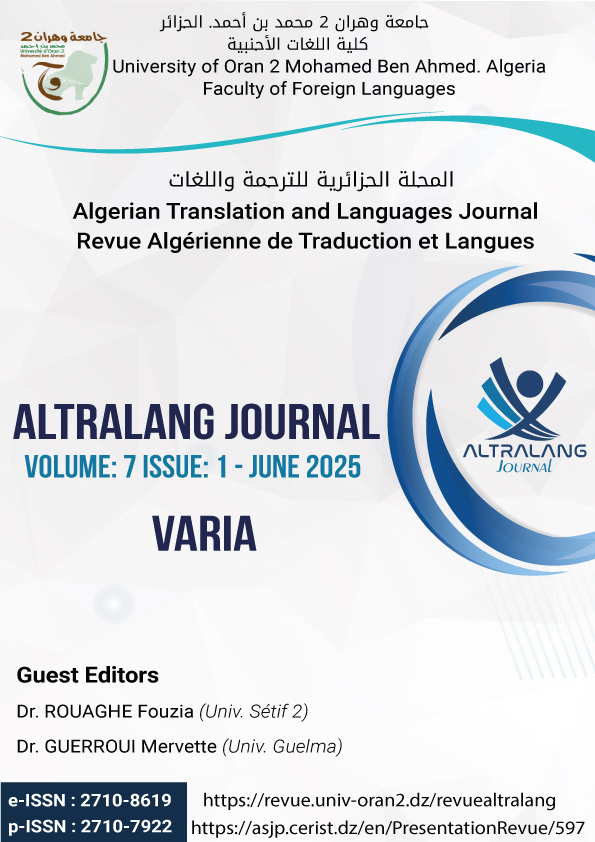Transposition et adaptation transculturelle des œuvres Sous les tilleuls d'Alphonse Karr et Cyrano de Bergerac, Le poète d'Edmond Rostand par El-Manfalouti : Majdoline, Ashâ’ir Transposition and Transcultural Adaptation of the Works Under the Linden Trees by Alphonse Karr and Cyrano de Bergerac, The Poet by Edmond Rostand by El-Manfalouti: Majdoline, Ashâ’ir
Main Article Content
Abstract
ABSTRACT: This article examines the transposition and transcultural adaptation of the works "Under the Linden Trees" by Alphonse Karr and "Cyrano de Bergerac" by Edmond Rostand by the writer El-Manfalouti in his works "Majdoline" and "Ashâ’ir". The analysis focuses on the artistic and linguistic choices made by El-Manfalouti in the process of translating and adapting these classics of Western literature into the Arabic cultural and linguistic context. The article explores the generic transformations, cultural adjustments, and adaptation strategies used by the Egyptian writer, highlighting the nuances and challenges of literary transposition between cultures. Additionally, it examines the impact of these adaptations on the reception and understanding of the works by the Arab-speaking audience, thus providing an insight into the complex interaction between the original texts and their adapted versions in a transcultural context.
RÉSUMÉ : Le présent article examine la transposition et l'adaptation transculturelle des œuvres "Sous les tilleuls" d'Alphonse Karr et "Cyrano de Bergerac" d'Edmond Rostand par l'écrivain El-Manfalouti dans ses œuvres "Majdoline" et "Ashâ’ir". L'analyse se concentre sur les choix artistiques et linguistiques effectués par El-Manfalouti dans le processus de traduction et d'adaptation de ces classiques de la littérature occidentale vers le contexte culturel et linguistique arabe. L'article explore les transformations génériques, les ajustements culturels et les stratégies d'adaptation utilisées par l'écrivain égyptien, mettant en lumière les nuances et les défis de la transposition littéraire entre les cultures. En outre, il examine l'impact de ces adaptations sur la réception et la compréhension des œuvres par le public arabophone, offrant ainsi un aperçu de l'interaction complexe entre les textes originaux et leurs versions adaptées dans un contexte transculturel.
Article Details

This work is licensed under a Creative Commons Attribution 4.0 International License.
LICENSE: This work is licensed under a Creative Commons CC BY 4.0 license
References
• Bensimon, P. (1990). « Présentation » de Palimpsestes n° 3, Presses de la Sorbonne Nouvelle, Paris. p. 9-13.
• Berman, A. (1984). L'Épreuve de l'étranger : Culture et traduction dans l'Allemagne romantique. Gallimard. Paris.
• Bhabha, H. K. (1994). La localisation de la culture. Londres : Routledge.
• Cary, E. (1985). Comment faut-il traduire ? Presses Univ. Septentrion.France .
• Dolet, É. (1540). La manière de bien traduire d'une langue en autre : d'advantage de la punctuation de la langue françoyse. Lion, France. Récupéré sur https://gallica.bnf.fr/ark:/12148/bpt6k87101658, consulté le 24 fév 2024.
• El-Manfalouti, M. (1912). Majdouline. Beyrouth : Dâr al-sharq al-arabi.
• El-Manfalouti, M. L. (1912). Les Regards. Beyrouth : Dâr al-sharq al-arabi. https://books.openedition.org/apu/5758?lang=fr. Consulté le 14Janvier 2024.
• Hutcheon, L. (2006). Une théorie de l'adaptation. New York : Routledge.
• Johnson, M. A. (1984). Translation and Adaptation. Meta, XXIX(4), 421-425
• Karr, A. (1861). Sous les tilleuls. Calimann : Levy, éditeurs.
• Ladmiral, J.-R. (1994). Traduire : Théorèmes pour la traduction. Paris : Gallimard.
• Lefevere, A. (1992). Traduction, Réécriture et Manipulation du texte littéraire. Actes Sud.
• Lotfi Al-Manfalouti, M. (s.d.). Ashâ’ir. Beyrouth, Al-maktabah Chaâbiya.
• Mariaule, M. (2020). In La Traductologie dans tous ses états : L’adaptation à l’épreuve de la traduction, université, Artois Presses Université. P.235-253.
• MESSAOUDI, H. (2024). Quand la traduction devient mode d’écriture, École Normale Supérieure de Martil – Maroc. https://post-scriptum.org/03-08-quand-la-traduction-devient-mode-decriture/, consulté le 25 jan 2024.
• Nida, E. A. (1964). Vers une science de la traduction, Leiden : Brill.
• Perez, H. (1959). La littérature arabe et l’islam par les textes. Paris, Maisonneuve.
• Rostand, E. (1983). Cyrano de Bergerac. Paris, Librairie Générale Française.

1.png)